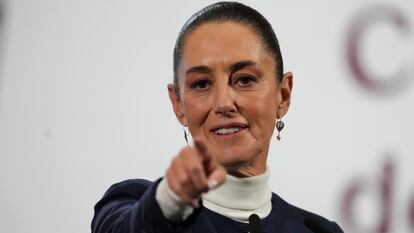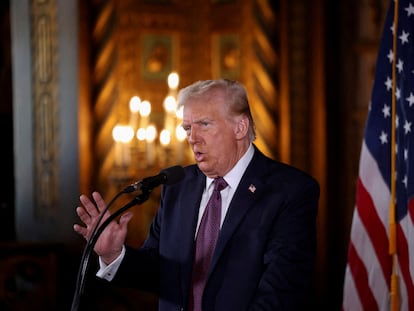Trump suspends tariffs on Mexico for a month after talks with Claudia Sheinbaum
Mexican government agrees to deploy 10,000 National Guard to the border to fight drug trafficking and irregular immigration

The countdown for goods to stop moving freely across the U.S.-Mexico border has been stopped after Washington and Mexico City reached a last-minute agreement to halt the imposition of tariffs for a period of one month. “We had a good conversation with President [Donald] Trump, with a lot of respect for our nation and sovereignty,” said Mexican President Claudia Sheinbaum. The U.S. president confirmed the agreement. Trump is scheduled to speak later with Canadian Prime Minister Justin Trudeau. It is unknown whether there will also be a postponement of tariffs on the United States’ northern neighbor.
Sheinbaum announced that her government will deploy 10,000 National Guard troops immediately to curb drug trafficking, particularly that of fentanyl, while Washington has committed to combating illegal firearms trafficking. “Our teams will start working today on two aspects: security and trade,” the Mexican president added.
The agreement comes as a surprise, on the verge of one of the worst crises that the bilateral relationship has faced in decades and while both countries were fine-tuning the final details to embark on a trade war. The agreement was reached after a call held at 8 a.m. Monday and which lasted more than half an hour, according to details shared by the Mexican government. “It was the work of the whole team,” said Sheinbaum as she announced a series of pacts for cooperation on the border. “Finally, we came to an agreement,” she said.
Trump confirmed the agreement to suspend tariffs on Mexico for a month: “I just spoke with President Claudia Sheinbaum of Mexico. It was a very friendly conversation wherein she agreed to immediately supply 10,000 Mexican Soldiers on the Border separating Mexico and the United States. These soldiers will be specifically designated to stop the flow of fentanyl, and illegal migrants into our Country. We further agreed to immediately pause the anticipated tariffs for a one month period during which we will have negotiations headed by Secretary of State Marco Rubio, Secretary of Treasury Scott Bessent, and Secretary of Commerce Howard Lutnick, and high-level Representatives of Mexico. I look forward to participating in those negotiations, with President Sheinbaum, as we attempt to achieve a “deal” between our two Countries,” the U.S. president wrote on his social network, Truth Social.
The tariffs decreed by Trump came into force on February 4. Trump announced Monday that he had also spoken with Trudeau, and that he would do so again later on Monday. The first conversation was not very productive, according to a message posted by the Republican magnate. “Canada doesn’t even allow U.S. Banks to open or do business there. What’s that all about? Many such things, but it’s also a DRUG WAR, and hundreds of thousands of people have died in the U.S. from drugs pouring through the Borders of Mexico and Canada. Just spoke to Justin Trudeau. Will be speaking to him again at 3:00 P.M.,” he wrote. In fact, while police and customs agents have seized close to 10 tons of fentanyl at the southern border, at the border with Canada the figure has not reached even 20 kilos. It remains unclear whether Trump will also suspend tariffs on Canada when he speaks to Trudeau again.
Trump had announced Sunday that he would speak with Trudeau and Sheinbaum, but he did not seem to hold high expectations. “I don’t expect anything dramatic. We put tariffs on. They owe us a lot of money, and I’m sure they’re going to pay,” he told reporters after stepping off Air Force One on his return to Washington after spending the weekend at Mar-a-Lago, his mansion in Palm Beach (Florida).
Asked what Canada and Mexico have to do to get the tariffs lifted, Trump again hinted that fentanyl and immigration, the official arguments, were more of a pretext and that what this is really about is an economic war. “They have to balance out their trade, number one. They’ve got to stop people from pouring into our country, and we’ve stopped it. They haven’t stopped it. We’ve stopped it. They have to stop people pouring in, and we have to stop fentanyl. And that includes China,” he replied.
From January to November 2024, the United States imported $466.6 billion worth of goods from Mexico, purchased $337.2 billion worth of goods from Canada, and imported $401.4 billion worth of goods from China. The largest trade deficit in that period was with China, amounting to $270.4 billion, followed by Mexico ($157.2 billion) and Canada ($55 billion). Trump has exaggerated those numbers time and again and falsely presented them as subsidies.
In his remarks Sunday he lashed out specifially at Canada and warned against possible retaliation: “It’s been a one-way street. We subsidize Canada to the tune of about $200 billion a year. And for what? What do we get out of it? We don’t get anything out of it. Something is going to happen there. If they want to play the game, I don’t mind, we can play the game all they want. Mexico, we’ve had very good talks with them.”
Tariffs on the European Union
Trump also insisted that there will be tariffs on the euro zone: “It will definitely happen with the European Union, I can tell you that, because they’ve really taken advantage of us, as I said,” Trump said, claiming a $300 billion deficit with the bloc. “I wouldn’t say there’s a timeline, but it’s going to be pretty soon,” he added, reiterating a message he already launched Friday from the White House.
The U.S. president has promised to open new fronts in the trade war with sectoral levies on products such as pharmaceuticals, oil, semiconductor chips, steel, aluminum, or copper. The Republican proposed on the campaign trail to impose reciprocal tariffs on U.S. imports equal to the rates that trading partners impose on U.S. exports (which are usually higher). On top of that (or overlapping) would be a universal base tariff of 10% to 20% on all imports. For China, Trump promised a 60% tariff on all imports.
Tariffs on U.S. imports from Mexico, Canada, and China have already caused an earthquake in the financial markets. Since the opening of trading desks in Asia, the dollar soared against major currencies and approached parity with the euro. The greenback hit record highs against the Canadian dollar, the Chinese yuan, and the Mexican peso. The stock markets suffered sharp falls, with the punishment concentrated on exporting companies and those with exposure to the United States through Mexico or Canada. Meanwhile, oil prices rose due to possible distortions in the market. Uncertainty and increased risk aversion also caused sharp falls in cryptocurrencies. With the announcement of the suspension of tariffs to Mexico, most of the previous movements were reversed.
Trump also spoke Sunday about the potential self-inflicted damage of tariffs on the U.S. economy. “We may have short term a little pain, and people understand that. But long term, the United States has been ripped off by virtually every country in the world,” he said. “We have deficits with almost every country, not every country, but almost, and we’re going to change it. It’s been unfair.”
Sign up for our weekly newsletter to get more English-language news coverage from EL PAÍS USA Edition
Tu suscripción se está usando en otro dispositivo
¿Quieres añadir otro usuario a tu suscripción?
Si continúas leyendo en este dispositivo, no se podrá leer en el otro.
FlechaTu suscripción se está usando en otro dispositivo y solo puedes acceder a EL PAÍS desde un dispositivo a la vez.
Si quieres compartir tu cuenta, cambia tu suscripción a la modalidad Premium, así podrás añadir otro usuario. Cada uno accederá con su propia cuenta de email, lo que os permitirá personalizar vuestra experiencia en EL PAÍS.
¿Tienes una suscripción de empresa? Accede aquí para contratar más cuentas.
En el caso de no saber quién está usando tu cuenta, te recomendamos cambiar tu contraseña aquí.
Si decides continuar compartiendo tu cuenta, este mensaje se mostrará en tu dispositivo y en el de la otra persona que está usando tu cuenta de forma indefinida, afectando a tu experiencia de lectura. Puedes consultar aquí los términos y condiciones de la suscripción digital.
More information
Archived In
Últimas noticias
Chris Martin, Taylor Swift, Elijah Wood and other famous wedding ‘crashers’
‘How does it feel to be a failure?’: Elizabeth Berkley’s journey from ‘Showgirls’ ridicule to vindication
The story of the Málaga virus: The code that haunted Google’s cybersecurity center director for 30 years
The impact of Ecuador’s mega-prison: A polluted river, cleared forests and military checkpoints
Most viewed
- Christian Louboutin: ‘Young people don’t want to be like their parents. And if their parents wear sneakers, they’re going to look for something else’
- The low-cost creative revolution: How technology is making art accessible to everyone
- All the effects of gentrification in one corner of Mexico’s Colonia Roma
- Liset Menéndez de la Prida, neuroscientist: ‘It’s not normal to constantly seek pleasure; it’s important to be bored, to be calm’
- December Social Security and SSI payments: Dates, double checks and the 2026 COLA increase










































